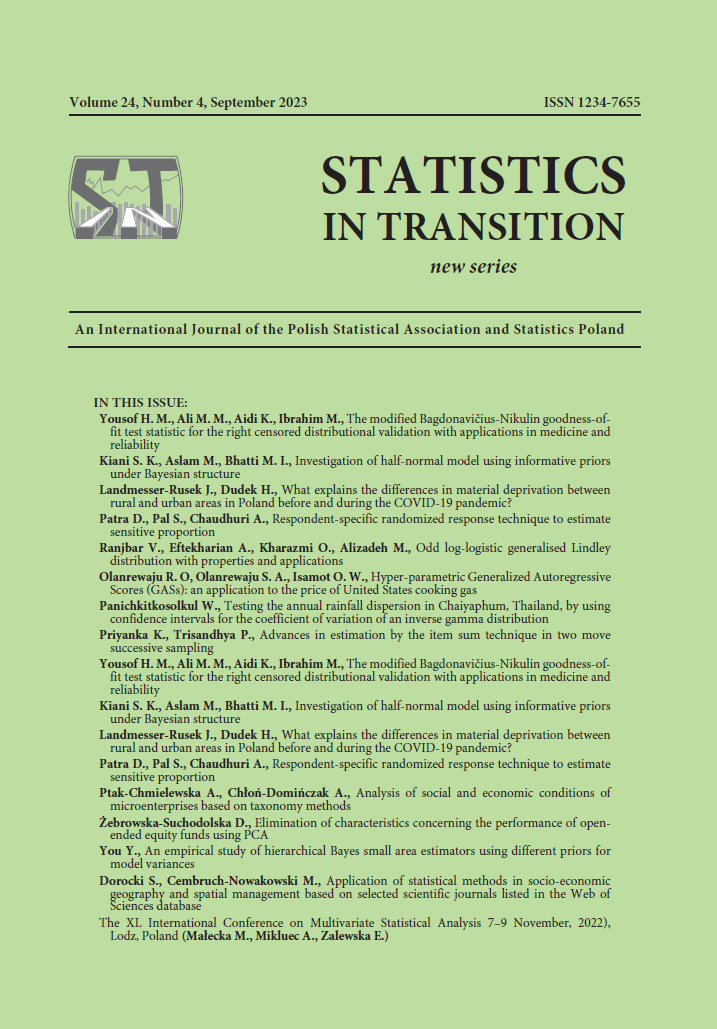ARTICLE
ABSTRACT
In estimating the proportion of people bearing a stigmatizing characteristic in a community of people, randomized response techniques are plentifully available in the literature. They are implemented essentially using boxes of similar cards of two distinguishable types. In this paper, we propose a more general procedure using five different types of cards. A respondent-specific randomized response technique is also proposed, in which respondents are allowed to build up the boxes according to their own choices. An immediate objective for this change is to enhance, sense of protection of privacy of the respondents. But as by-products, higher efficiency in terms of actual coverage percentages of confidence intervals and related features are demonstrated by a simulation study, and superior jeopardy levels against divulgence of personal secrecy are also reported to be achievable. AMS subject classification: 62D05
KEYWORDS
protection of privacy, randomized response, sensitive issues, varying probability sampling
REFERENCES
Anderson, H., (1975b). Efficiency versus Protection in a General RR model, Technical Report 10, University of Lund, Lund, Sweden.
Anderson, H., (1975c). Efficiency versus Protection in RR Designs. Mimeo notes, University of Lund, Lund, Sweden.
Anderson, H., (1975a). Efficiency versus Protection in the RR for Estimating Proportions. Technical Report 9, University of Lund, Lund, Sweden.
Arnab, R., Mothupi, T., (2015). Randomized Response Techniques: A Case Study of the Risky Behaviors’ of Students of a Certain University. Model Assisted Statistics and Applications, Vol. 10, pp. 421–430.
Barabesi, L., Diana, G., Perri, P. F., (2013). Design-based distribution function estimation for stigmatized population. Metrika, Vol. 76, pp. 919–935.
Boruch, R. F., (1972). Relations Among Statistical Methods for Assuring Confidentiality of Social Research Data. Social Science Research, Vol. 1, pp. 403–414.
Chaudhuri, A., (2011). Randomized Response and Indirect Questioning Techniques in Surveys. Boca Raton: CRC Press.
Chaudhuri, A., Christofides, T. C., Rao, C. R., (2016). Handbook of Statistics, Data Gathering, Analysis and Protection of Privacy Through Randomized Response Techniques: Qualitative and Quantitative Human Traits, Vol. 34, NL: Elsevier.
Chaudhuri, A., Christofides, T. C., Saha, A., (2009). Protection of Privacy in Efficient
Application of Randomized Response Techniques. Statistical Methods and
Applications, Vol. 18, pp. 389–418.
Chong, A. C., Chu, A. M., So, M. K., Chung, R. S., (2019). Asking Sensitive Questions Using the Randomized Response Approach in Public Health Research: An Empirical Study on the Factors of Illegal Waste Disposal. International Journal of Environmental Research and Public Health, Vol. 16, pp. 970.
Diana, G., Perii, P. F., (2013). Randomized Response Surveys: A note on some privacy protection measures. Model Assisted Statistics and Applications, Vol. 8, pp. 19–28.
Fox, J., Veen, D., Klotzke, K., (2018). Generalized linear mixed models for randomized responses. Methodology: European Journal of Research Methods for the Behavioral and Social Sciences, Vol. 15, pp. 1–18.
Greenberg, B. G., Abul-Ela, A. L., Simmons, W. R.,Horvitz, D. G., (1969). The unrelated question randomized response model: theoretical framework. Journal of American Statistical Association, Vol. 64, pp. 520–539 .
Horvitz, D. G., Thompson, D. J., (1952). A generalization of sampling without replacement from a finite universe. Journal of American Statistical Association, Vol. 47, pp. 663–685 .
Hout, A. V., Heijden, P. G., Gilchrist, R., (2007). The logistic regression model with response variables subject to randomized response. Computational Statistics & Data Analysis, Vol. 51, pp. 6060–6069.
Kuk, A. Y., (1990). Asking Sensitive Questions Indirectly. Biometrika, Vol. 77, pp. 436–438.
Lahiri, D. B., (1951). A method of sample selection providing unbiased ratio estimates. Bulletin of International Statistical Institute, Vol. 3, pp. 133–140.
Lanke, J., (1975). On the choice of the unrelated question in Simmons' version of randomized response. Journal of American Statistical Association, Vol. 70, pp. 80–83 .
Lanke, J., (1976). On the degree of protection in randomized interviews. International Statistical Review, Vol. 44, pp. 197–203.
Leysieffer, R. W., Warner, S. L., (1976). Respondent jeopardy and optimal designs in randomized response models. Journal of American Statistical Association, Vol. 71, pp. 649–656 .
Midzuno, H., (1952). On the sampling system with probability proportional to the sum of the sizes. Annals of Institute of Statistical Mathematics, Vol. 3, pp. 99–107.
Pal, S., Chaudhuri, A., Patra, D., (2020). How privacy may be protected in Optional Randomized Response Surveys. Statistics in Transition, Vol. 21, pp. 61–87.
Sen, A. R., (1953). On the estimator of the variance in sampling with varying probabilities. Journal of Indian Society of Agricultural Statistics, Vol. 5, pp. 119–127.
Van der Heijden, P. G., Van Gils, G., Bouts, J., Hox, J., (2000). A Comparison of Randomized Response, Computer-Assisted Self Interview, and Face to Face Direct Questioning: Eliciting Sensitive Information in the Context of Welfare and Unemployment Benefit. Sociological Research & Methods, Vol. 28, pp. 505–537 .
Warner, S. L., (1965). Randomized response: a survey technique for eliminating evasive answer bias. Journal of American Statistical Association, Vol. 60, pp. 63–69.
